#Yashica Auto Focus
Text

Yashica Auto Focus Motor. Ilford Delta 400.
#film photography#35mm photography#film is not dead#believeinfilm#35mm film#ishootfilm#street photography#travel photography#photographers on tumblr
55 notes
·
View notes
Text

© Paolo Dala
Focus Lang
I've been using my Yashica Electro 35 GS lately. It's a 35 mm film camera from the 1970s that's very difficult to focus for a photographer like me who's been on auto-focus all my life. The Electro 35 GS' viewfinder is not connected to its lens. You focus the lens be estimating the distance (in m or in ft) of the camera from you preferred subject and adjusting the lens with the corresponding focus setting.
I need more practice, but I'm really enjoying the challenge!
#Yashica Electro 35 GS#35 mm#Film#Film Photography#Yashica#People#Christmas#Christmas Party#Marikina City#Philippines
1 note
·
View note
Text
Buy prints of my photos: DARKROOM
If there is a certain photo you'd like to buy, please let me know.
I use this blog to post my film photos, you can check out my instagram and other sites too here:
Instagram
Lomography
Current Film Camera:
Canon 35AF ML
Past Cameras:
Yashica Auto Focus Motor IID
2 notes
·
View notes
Text
Yashica Auto Focus 35mm film camera
CAMERA DEALS: Seller: 650minolta7i (100.0% positive feedback)
Location: US
Condition: Used
Price: 24.97 USD
Shipping cost: 10.95 USD
Buy It Now https://www.ebay.com/itm/115842781100?hash=item1af8c48fac%3Ag%3AA78AAOSwkvhkl7pp&mkevt=1&mkcid=1&mkrid=711-53200-19255-0&campid=5338779481&customid=&toolid=10049&utm_source=dlvr.it&utm_medium=tumblr
0 notes
Text
Yashica Auto Focus Motor IID
On a Saturday afternoon in November last year, I was walking by 100ft road Indiranagar when my eyes landed up on a guy on the side of the road with a makeshift shop selling an assortment of vintage junk. The guy must have been in his fifties, his eyes were set deeply in the dark socket from where his smudged yellow eyes glistened. He had sleek black hair parted from the middle, pulled back like Bollywood heroes of the early 90s. It was a befitting look for the stuff he had lined up on his roadside shop. There were walkman, camcorders, round dial telephones, old LP records, and plenty of point-and-shoot film cameras. I am a sucker for nostalgia, but an even bigger sucker for film cameras. I had always wanted a point-and-shoot camera because its mobility of it feels like a blessing at times. Most of the cameras he had were in pretty roughed-up condition, except for a Yashica AF. This model stood out, built like a sturdy plastic soap box with some nifty features like a sliding lens cover. I also have a soft spot for Yashica cameras because my father had a Yashica SLR, so my heart for this new find at this roadside shop started to melt. The shopkeeper very smartly kept no batteries to check whether the camera worked. After my pathetic negotiating skills, we settled for a price of 2K.
Thankfully, Nidhi pitched in and agreed on 1K and 500 later only if the camera worked. We decided to take it to Prabhu's photo shop on Brigade to see if it had any life left. We put the pencil cells through the loose hinges of the battery case area. Hit the shoot button but it did nothing. Mr Prabhu obliged us by trying his experience on it. He rewound the film roll motor by pressing it, and it made a screeching noise and kicked to life. But it still won't shoot. So I had a camera that could walk but not see. Mr Prabhu offered to get it fixed, and even with the risk of paying the repair cost, it was worth seeing it through because the gains were much higher than the losses at that point. I waited for a couple of weeks, anticipating whether I will have a showpiece coming back or a camera I could shoot with. Thankfully, my luck had not gone to sleep, and the camera came back in working condition. Although, a few things were still off. The camera could shoot even with the lens cap covered, so I wasted quite a few shots taking blank shots because, after years of shooting on an SLR, you get assured of the lens cap not being on the camera because your viewfinder will tell you so! The camera also would roll through multiple shots without taking a shot. It happened more when the shutter was pressed for a slightly longer duration. It's a glitch that I had no clue how to tackle because at times it would do this even with a light press. The flash would also work groggily at times because you would have to wait for some time before it would actually fire, so there went a few shots down the sinkhole.
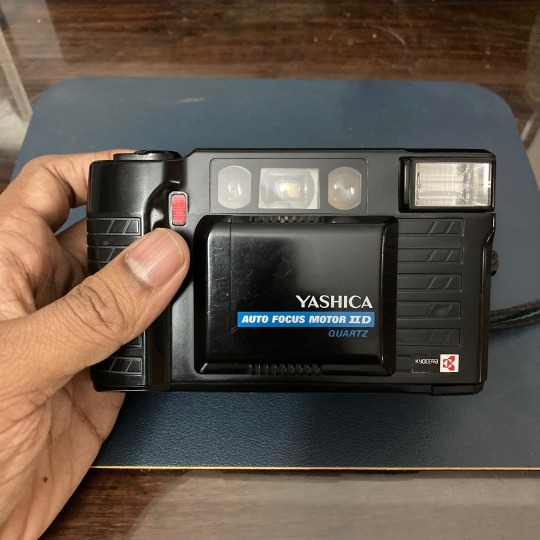
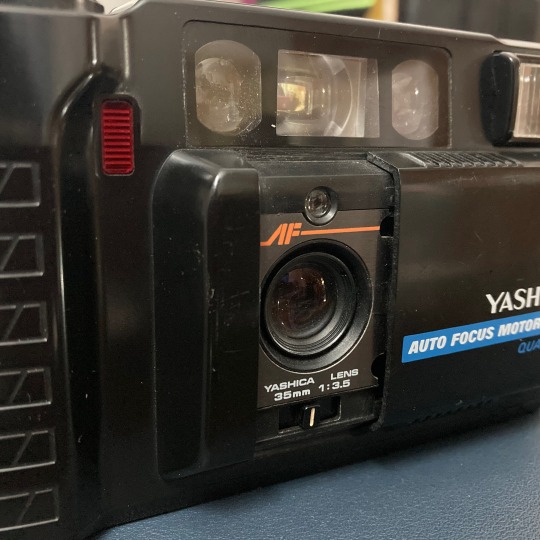

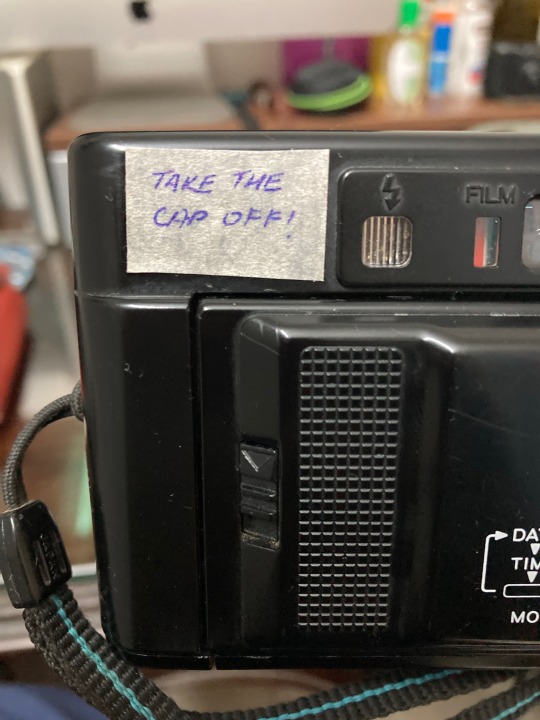
I don't know if monetarily it was of any gain to pick this camera up from the roadside, but the whole fun is not knowing what you would actually end up with. Took quite a few shots of Sufi with this camera,.







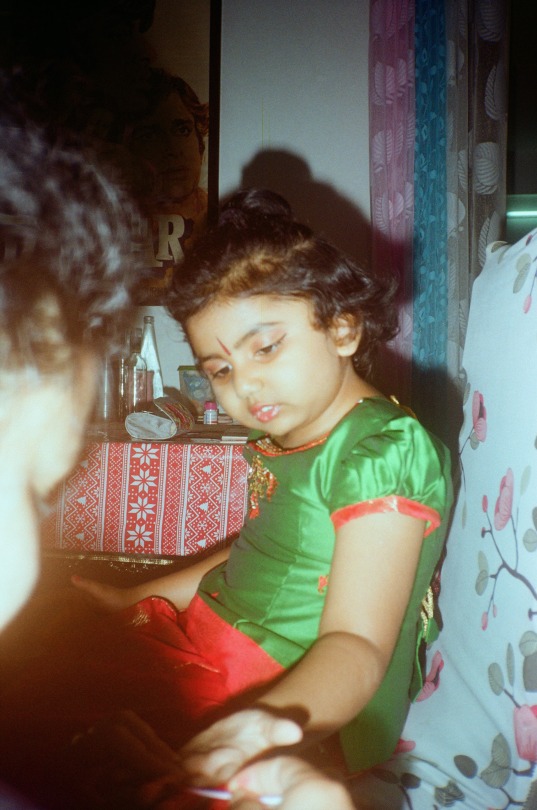
0 notes
Photo



Recently picked up this Yashica Auto Focus 35mm film camera to play with.
0 notes
Photo

Behind the scenes Orange is the New Black, season 6.
Queens, NY. Aug, 2017.
#Amanda Uribe#film#yashica#yashicat3#35mm#portra400#kodak#point and shoot#auto focus#bts#orange is the new black
4 notes
·
View notes
Text


Breakfast time! • Long Hai., Viet Nam - 10/2018
Yashica Auto Focus Motor D • Kodak Colorplus 200
#35mm film#kodak colorplus 200#film photography#filmisnotdead#yashica#breakfast#photographers on tumblr#original photographers#vietnam
3 notes
·
View notes
Text

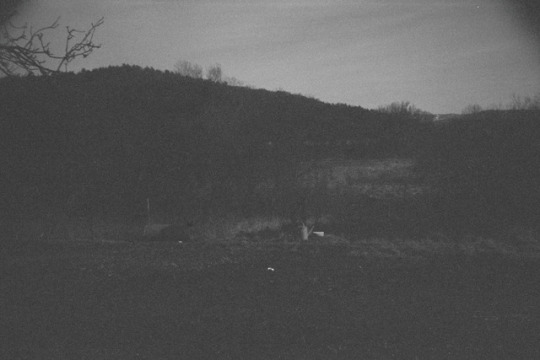
Yashica Auto Focus
/black and white film test/
2 notes
·
View notes
Text

Bon Iver on film.
Yashica Auto Focus Motor. Kodacolor 200.
#film photography#35mm photography#film is not dead#believeinfilm#35mm film#ishootfilm#shitty camera challenge#bon iver#concert photography#believe in film
17 notes
·
View notes
Photo





Ein erster (und vielleicht einziger) Film mit einer Kamera vom Flohmarkt, einer Yashica AUTO focus von 1975. Die Kamera hat Probleme, scharf zu stellen, aber wenn sie es schafft, dann kommen recht witzige Fotos heraus. Mehr darüber unter:
http://zeitmaschinen.org/wp-admin/post.php?post=484&action=edit&lang=de
From my first (and probably only) film with a camera from a garage sale, a Yashica AUTO focus from 1975. The camera has great difficulties to focus but when it succeeds i like the results quite a lot.
More of my pictures:
https://www.flickr.com/photos/153635104@N05
3 notes
·
View notes
Text
Yashica Auto Focus Motor Full Automatic 35mm Point & Shoot Film Camera *READ*
CAMERA DEALS: Seller: sfg_sports (100.0% positive feedback)
Location: US
Condition: Used
List price: 59.95 USD
You save: 6.00 USD (10% off)
Current price: 53.95 USD
Shipping cost: Free
Buy It Now https://www.ebay.com/itm/354848104282?hash=item529e985f5a%3Ag%3AsYEAAOSwijVkiPxj&amdata=enc%3AAQAIAAAA4FgTDpT3PR1nx2e5vYMtbdDgvmMY%2BtN88is1Z6%2BhK6JSq6S8dWORX8woGF5lxDsyYIllX57oMM%2BQSrBi%2BbDWjOED0PNfBxLhxabqGq%2B25GulCnQoVf4flIl%2FbGdVa4sdu48UIJWb6pVegtbTX5Wl7C%2FBtpwC31EwgW2tiS6iBAN9%2BuH0atxyMqM9VVB9gjLkS1h2z2KHxWmyIa75llAS1pGXGAuI%2BY7pCWxwqITqPNugHbalT8lcVKTaXrSCIV1U2zCipGTv5QC2CkFYEBV5QY2s0yUuMsE%2B1FCDTe2I1pdO&mkevt=1&mkcid=1&mkrid=711-53200-19255-0&campid=5338779481&customid=&toolid=10049&utm_source=dlvr.it&utm_medium=tumblr
0 notes
Text
The 10 Hottest 35mm Cameras You Could Buy in 1991
1991. What a great time to be alive. Seeing movies like Robin Hood and Hook in the theatres, and hearing hits like “Joyride” by Roxette or “Losing My Religion” by REM are some of my favorite pop culture memories of that time. Not to mention watching TV shows like Home Improvement, America’s Funniest Home Videos, and The Fresh Prince of Bel-Air.
Of course, being eleven years old, my photography experience was limited to disposable cameras, but that might not be the case for you. If you were older or luckier, you might have had one of these classic or innovative cameras I’ll be talking about today.
Today I’m going to go over the top ten hottest 35mm cameras you could buy in 1991.
A couple of things I want to mention about this list before I get started.
I constructed the list with a few parameters in mind. First, I used Popular Photography’s Top Cameras for 1991 as the base for it. Next, I boiled the list down from twenty to ten, by selecting the ones still most relevant today. The higher number of Google results, the higher it appears on the list.
Read also: 10 of the Hottest 35mm Cameras You Could Buy in 1982
In this golden age of photography, which in my opinion was 1975 to 1995, many of the cameras released had a very long shelf life. Because of that, if I include the older models, my top ten list could have several of the same entries, even if I jump ahead nine years. So for that reason, I have put a cap on cameras to be no older than seven years from the year featured.
That brings me to the last bit, which is this isn’t a list of cameras released in 1991, rather it is a list of the hottest cameras you could buy in 1991. As I mentioned, some of these entries had been out for a few years by 1991.
With all that being said, let’s get started.
#10. Yashica 230 AF
The first camera on today’s list may be a bit of an unknown these days: the Yashica 230 AF. An early auto-exposure camera, with three modes plus manual. The 230 AF was announced in 1986 but immediately caused some controversy, as mentioned in an article by Norman Goldberg, released by Popular Photography in November 1986.
“Yashica created a stir when the company was forced to withdraw its newest entry in the autofocusing fray. Called the 230 AF, the camera quickly became the subject of a patent dispute, but not before several German-language photo magazines came out with the details on the camera. To satisfy the affronted party – perhaps Minolta – the camera was displayed in a locked showcase. Word is that the matter will be resolved soon.”
Despite the early controversy, the 230 AF made its debut in 1987. One of the more interesting features was the CS-110AF flash accessory, which fit over the hot shoe and pentaprism to give a seamless appearance, it almost makes it look like another camera.
Picking up one of these in 1991 with the flash and a 50mm f/1.8 would cost you $765, or $1,536 today. There are not many found on eBay but if you want one of your own you can expect to get one for under $100
#9. Olympus IS-1
At number nine is the Olympus IS-1. A very strange-looking camera. Even stranger at the time because cameras like this marked the birth of the bridge model. A camera that included many of the manual and auto exposure modes of an SLR, but with a fixed lens like a point and shoot.
Because it didn’t fit into an already established category of camera, Olympus dared to make their own, calling it a ZLR, or Zoom Lens Reflex. This was absolutely a marketing gimmick, but it seemed to work. The IS-1 garnered a fair amount of attention.
In December 1990, Mike Stensvold conducted a thorough review in Petersen’s Photographic on the IS-1 and concluded that “The Olympus IS-1 comes closer than most to truly being a ‘camera for everybody.’ In point and shoot mode, it’s as simple to use as any camera in its class. It offers versatility to the more creative snap shooter and it’s got some advanced features found in few other such cameras, making it useful to more serious photographers, as well.”
Olympus’s goal was centered around the idea that this was a new concept camera and the wave of the future. This three-page ad, published in November 1990 encompasses that notion by posing the question: “Remember the first time you received a fax, talked on a cellular phone or heard a CD”?
In 1991 you could expect to pay $800, or $1,600 in today’s money. If you want to buy one used on eBay they are cheap as chips.
I actually did a very detailed history on this camera recently on an episode of my show This Old Camera, in case you want to learn everything there is to know about the Olympus IS-1.
#8. Nikon N8008
Coming in at number eight is the Nikon N8008, funny how that worked out. A consumer-level autofocus SLR with some impressive features for its time including a 1/8000th shutter speed and a flash sync speed of 1/250.
While many camera manufacturers of the time were abandoning their lens mounts from the days of manual focus SLRs, Nikon was staying true to their user base by creating a new autofocus system that could still take older manual focus lenses with a fair amount of compatibility.
Peter Burian conducted a field test and wrote about it in the Winter 1989 issue of Outdoor and & Travel Photography magazine.
“Though the N8008 is clearly an advanced and sophisticated piece of high-tech engineering, it is exceedingly user-friendly,” says Burian. “I predict that any photographer who can operate a digital watch or VCR will be familiar with the N8008 and its use within 30 minutes.”
Peter also says it handles like a dream but had a couple of hang-ups about its operation. He noted that although the N8008 is capable of continuous autofocus, he nailed more sharp images with the standard AF.
The advertising campaign for the N8008 bore the title: “The difficult is does automatically. The impossible takes a few more seconds.”
Here are a couple of examples from 1989.
This one with the ballerina touches on the matrix metering system, and rear curtain fill flash. “The point is,” says the ad, “highly creative pictures that used to be difficult to impossible for anyone less than a professional photographer are now within your grasp.”
The other ad sings a similar tune stating “Ordinary exposure control systems could be fooled by the dark black sky and overexpose the lighted skyline.”
A brand new N8008 with a 50mm f/1.4 would cost you $960 1991 dollars, or $1,928 today. This camera is an unsung hero in today’s film photography community and comes in at an incredibly low price of $70 or less with shipping, body only.
#7. Contax RTS III
At number seven is the Contax RTS III. In a time when autofocus was quickly becoming King, the people at Kyocera decided to make a more streamlined, more sophisticated manual focus SLR. The first thing that people will notice is that the RTS III uses Zeiss glass, known for its build quality and sharpness. But the thing that reviewers and adverting talked about the most was a feature called RTV, or Real Time Vacuum.
In a user report, published by Petersen’s Photographic in 1991 and written by Bill Hurter, it’s explained that the RTV system is engaged when the shutter fires, and sort of sucks the film back onto the pressure plate, creating a flatter image, thus creating a sharper image.
“Roll film in cassettes was a great breakthrough, but one of its problems has always been that film curls,” says Hurter. “It curls because it is rolled into a cassette. Also temperature and humidity affect the degree of curl. Contax engineers have shown film-plane flatness error to exist in current state-of-the-art SLRs to a degree of 20-30 microns in extreme cases. Further, the contention is that a 10 micron error in film plane flatness would cause a rear focus displacement of approximately 1 cm in an image shot at a distance of 3 meters with a Zeiss 85mm f/1.4.”
Basically, you don’t buy a Contax RTS III for quick focus, but superior focus.
A 1992 ad titled “See through the eyes of a genius” gives the reader a visual of what the RTV does to film flatness and showcases the Zeiss glass.
The price on an RTS III with a 50mm f/1.4 would set you back $3,630 in 1991, or about $7,300 today — a steep investment for a manual focus camera in a progressively autofocus world, but still not the most expensive manual focus camera on today’s list.
#6. Minolta Maxxum 9000
Number six is the Minolta Maxxum 9000. In January 1985, Minolta changed photography forever with the Maxxum 7000, and ten months later we were introduced to the 9000. While the 7000 was a model meant for the broadest audience possible, the 9000 geared itself toward the more serious amateur and professional.
In May 1986, Modern Photography had a very extensive look at the Maxxum 9000. Seeing how it compared to the 7000, which they noted that “Indeed its designers not only responded to virtually every criticism we made of the original 7000, they have also created one of the most sophisticated, comprehensive, internally complex and startlingly original SLR systems the world has ever seen.”
Popular Photography did their own field test in September 1986, praising the camera. But even when incredibly innovative, a camera is rarely perceived as perfect, and the Maxxum 9000 is no exception. Writer Bob Schwalberg had a few complaints for sure, including the average/spot metering setting didn’t have a lock on it, so a sleeve, or a strap or whatever would often change metering modes without him realizing it. Also the lack of lens selection.
“Almost two years after the launching of the Maxxum autofocusing camera system, Minolta’s AF lineup is heavy on zooms, but short on meat and potatoes workaday optics.”
At the time of review, they have nothing wider than 24mm, no 35mm, and not a single zoom in the 50-135mm range.
Advertising claimed the Minolta Maxxum 9000 to be “The World’s Most Sophisticated Camera” and encouraged you to “Ascend to the height of professionalism.” It seems in this ad, released in 1989, one of Bob’s issues was resolved, as I’m seeing a 16mm prime and a 35mm to what I presume to be 105mm lens.
With a 50mm f/1.7, a Maxxum 9000 would set you back $974 in 1991, or about $1,950 today.
#5. Leica R6
The Leica R6 comes in at number five. While many cameras take a leap forward from one version to the next, Leica actually took a step back, as quoted in a review by Jack Neubart in the fall 1990 issue of Outdoor and Travel Photography Magazine.
“Unlike the R5, the Leica R6 is principally mechanically governed. The R5 comes complete with several auto exposure modes, plus manual; but the R6 has only manual exposure control, with shutter speeds ranging from 1 second to 1/1000th of a second.”
Another review, in Outdoor Photographer’s October 1989 issue by Debra Davis sums up the purpose of the camera the best.
“In this day of electronic-laden auto-everything cameras, there is a new product on the market that stands apart from the rest. Welcome to the Leica R6. Designed to appeal to the photographer who wants mostly a mechanical, manual camera, the R6 shuns current trends and offers a back to basics approach to photography.”
This three-page special advertising section titled “The Shot of a Lifetime” features three Leica cameras including the R6. The main photo was taken during a Mount Everest climb with an R6 by photographer Warren Thompson.
“A camera which could be disabled by a failed, inexpensive battery would jeopardize the photographic mission,” says the ad.
The next page claims the R6 can withstand temperatures as low as -4F and as high as 140F.
Something that made me chuckle was this quote on page 2: “If Michelangelo were alive today, he wouldn’t be painting – he’d be using a Leica.”
I guess we’ll never know.
This Leica R6 ad titled: “Seduction” gives a really nice top-down look.
“You’re irresistibly drawn to it – seduced by the beauty, the precision, the mystique of legendary performance. Unlike mere ‘cameras,’ you don’t just hold a Leica, you caress it and feel the perfect balance, comfortable fit and smooth, positive operation – an extension of your hand, your eye and your art. You’ll be starting an affair with excellence that will last a lifetime whether you choose the manual R6, the electronic R5 or fast handling RE.”
Settle down there Leica.
During my research for other videos, I’ve come across quite a few Leica ads, and I have to say, many are like this one, and there’s a reason that some Leica owners have, shall we say, a superiority complex.
If you wanted to be seduced by this all manual beast, you better take out a second mortgage, because with a 50mm f/1.4 this Everest climber will cost $5,550 in 1991, or… wait for it… $11,147 in 2021 money. These days though, you can get one for a respectable $600 used. That Summilux-R 50mm f/1.4 will still choke your wallet though, at a cost of 1,200-1,800 bucks.
#4. Nikon F4s
Sliding in at number four is the Nikon F4s. I’m always curious to know the differences between models with slightly different names. In my top 35mm cameras of 1982 article, I was wondering what the big deal was between the Nikon F3 and F3HP, and the answer was, basically, the viewfinder.
Here I was again curious what the difference between the Nikon F4 and F4s was and the answer may amuse you: a battery pack. What makes an F4 an F4s is the MB-21 battery grip that takes six AA batteries and that is about it. You get a beefier camera and a slightly higher frames per second burst rate. With the MB-21, you can turn any F4 into an F4s. It’s a little sneaky on Nikon’s part, especially since it got its own advertising campaign.
Here are a couple of examples. The first here says “The Reasons” and brackets the ‘S’ and another example here it brackets the ‘es’ in Lenses. An odd choice. You’ll notice all the ads for the F4s include the battery grip because it has to.
Regardless, the Nikon F4 was a revolution for Nikon. They plunged into autofocus and while everyone else was remounting their cameras, Nikon stayed true to their user base by allowing older manual lenses on their newer autofocus cameras.
#3. Canon EOS-1
Getting the bronze medal for today’s top 10 is the other autofocus revolution flagship, the Canon EOS-1. Announced in 1989, the EOS-1 was not Canon’s first EF mount camera, but the first flagship model. As you can imagine, many FD mount Canon users were very upset that their cameras were antiquated overnight. History speaks for itself though and Canon survived the backlash.
The earliest ad I found was in September 1989’s issue of American Photographer, a colorful three-page ad, that would be one of a theme of ads with the suggestion, to quote “shoot it hot”.
“Live for photography. Eat Sleep and breathe it. Become a photograph.”
“Send the world your message…written in silver.”
I did a full history on the EOS-1 on my segment This Old Camera, in case you’re curious. After I released that video, my Patreon patrons and I were making “Shoot it Hot” jokes for weeks. It’s so incredibly cheesy and so very 90’s.
In September 1992, Camera & Darkroom magazine published: “A Quiet Revolution, A look at the Canon EOS Phenomenon,” by Mike Johnston.
Johnston took an in-depth look at Canon as a company, specifically their transition from FD mount to EOS, the controversy, and resulting innovations.
“When Canon introduced the EOS line in 1987, they immediately earned for themselves, among other things, a bad rap of sorts. The reason was the lens mount capability. The introduction of the new line was news; and the reaction from those heavily invested in expensive FD optics was swift, loud- and, to put it mildly, less than pleased.”
He would go on to say “even if you’re not a Canon photographer, it might be wise to keep your eye on them… if only to see which way the winds of change are blowing in the field of 35mm photography.”
A Canon EOS-1 with a 50mm f/1.8 would knock $1,939 out of your 90s Velcro wallet. Or about $3,900 today.
I paid $197 for the copy I have with an EF 28-105mm lens. It wasn’t in the best shape though, so expect to pay a little more.
#2. Leica M6
Obtaining silver for today’s countdown is the Leica M6. Is it any surprise that a Leica made it to the top 3?
A review by Debra Davis in the June 1991 issue of Outdoor Photographer explains the advantage of using a Leica quite well.
“The M6 allows the photographer to know what’s coming into the frame by displaying six distinct frame lines in the viewfinder window. These are projected in pairs corresponding to different focal length lenses for 28mm or 90mm, 35mm or 135mm, and 50mm or 75mm. The correct set automatically appears when you attach a lens and includes an area outside the frame line so you’ll be alert to something moving into the photo. In addition, you may manually select a different set of frame lines just by pressing a lever next to the lens. So without actually changing lenses, you can see and decide quickly, which lens to use for best composition.”
The ability to go unnoticed in a crowd is also touched on.
“The M6 is fast and silent, small and simple,” says Davis.
And here we go again with the melodrama, using the same ad theme as the R6, except this time it’s not Seduction, it’s …Obsession.
“It’s an almost unreasonable dedication to quality – meticulous attraction to detail, flawless mechanical precision, incredibly quick, quiet handling and optics that defy comparison – an obsession with perfection. It’s what sets Leica above mere “cameras” and accounts for their unchallenged reputation and unequaled value.”
If Jesus was alive today, he wouldn’t be a carpenter, he would be making Leicas.
Okay, I made that last part up, but it’s hard not to snicker at the hubris of it all. I will give Leica this, the commitment to only making small changes from model to model is impressive. Even as they transitioned to digital models, the design made very little change. You know that when you buy one, and ever feel like upgrading, you can do so knowing you won’t have a huge learning curve ahead of you.
The M6 might be second on the list, but it’s first in price. With a 50mm f/1.4, you can expect to pay $5,685 in 1991 cash, and just to give you a better idea of how much that is, in 1991, you could buy a used 1987 Dodge Omni for less, at a cost of just under $5,300. With inflation, an M6 was $11,418 in 2021 money. That is, just bonkers in my opinion. Especially when you consider that these days, you pay for the sensor in a high-end digital camera, but back then, everyone was using the same film.
Getting one on eBay is still going to be pricey. Body only is going to be three to four K.
#1. Olympus OM-4T
Coming in with the gold, is a camera you probably didn’t expect, the Olympus OM-4T. Maybe some of you did, as last time I made a list like this on the hottest of 1982, lots of you asked where the Olympus cameras were. The OM-1N came in at eleventh place in case you’re curious.
One of the features of the OM-4T that caught my eye while reading up on it was the ability to multi spot meter, as described in this review by Petersen’s Photographic writer Dan O’Neill in December 1986.
“Multi-spot metering is done by selecting different areas in the scene and metering each one with the press of the spot button. Up to eight spots can be metered and averaged by the OM-4T’s microcomputer.”
The other big deal with the OM-4T is the Full Syncro flash system. Basically, Olympus uses a focal plane shutter and that comes with its limits on how fast you can sync a flash to it. While many other manufacturers worked on a better shutter, Olympus just increased the duration of the flash system to properly gather all that light at quicker speeds. A focal-plane shutter has two curtains. A leading one and a trailing one, and at higher speeds the trailing curtain is already closing before the leading one has completed its cycle, so in the case of flash, you get an incomplete flash exposure.
Long story short, the OM-4T had a max flash sync speed of 1/2000, as promoted in an ad titled: “The first camera ever to break the light barrier.” They also called the multi spot meter function, “The most precise built-in meter in camera history.”
So what does the T stand for? According to David Brooks of Petersen’s Photographic, “the use of titanium for the bodies top and bottom plates. This exotic metal provides both lighter weight and greater strength to protect the camera’s internal circuitry to dedicate the new F-280 flash and integrate its special new capabilities into the OTF auto flash exposure control, auto-spot continuous light metering, and exposure automation.”
With a 50mm f/1.8 lens, the OM-4T will set you back $1,330 by 1991 standards, or just under $2,700 by today’s. These days you can expect to pay a respectable three to four hundred body only.
Conclusion
youtube
And that concludes today’s list. Thanks for reading and watching, and happy shooting!
About the author: Azriel Knight is a photographer and YouTuber based in Calgary, Alberta, Canada. The opinions expressed in this article are solely those of the author. You can find Knight’s photos and videos on his website, Twitter, Instagram, and YouTube.
from PetaPixel https://ift.tt/3nWJofa
0 notes
Photo

Yashica Super 800 Electro Super 8 Cine Film Camera & Case - Fully Working S82697
Inspection report
Tested and fully working, in great working condition. Comes with original case, manual, remote cable and lens cap.
Lens - clean, free of mould, dust, haze or damage
Focus - smooth, works well
Zoom - works well (both manual and power zoom)
Motor - runs well at all speeds
Exposure - working well
Body - in good condition, some light scratching
Battery compartment/s – tested and working well
Other features - all tested and working well.
We fully inspect all our cameras to ensure they’re fully working and offer a 60 day warranty giving you plenty of time to have a play with your purchase and make sure you’re totally satisfied.
Product Specification
Lens: Yashinon-DX 1,6 / 7,5 - 60 mm
Microprism Focusing
Auto / Manual Zoom
Frame rates: 12,18,24 + single frame
Auto Exposure
+/- correction for auto
Remote control socket
No sound
4 X 1,5V batteries + No separate battery for light meter
Made in Japan
UK shipping
CameraCrate.com offer free tracked shipping on all items being delivered to the UK. Due to the high value of our items, we require a signature on delivery for the vast majority of orders. Please note, that although the vast majority of items are delivered within 48-72 hours of dispatch, we’re unable to guarantee it.
We aim to dispatch orders within 24 hours of ordering (Monday-Saturday) although this can occasionally take slightly longer over bank holidays and during peak periods. If you require an item urgently, please contact us to discuss delivery options.
Worldwide shipping
CameraCrate.com are proud to deliver worldwide. Prices and times vary depending on size and location. Import duties, taxes, and brokerage fees are not included in the product price or shipping and handling cost. These charges are the buyer’s responsibility as we are only charging the transportation fee for your order. You may check with your country’s customs office to determine if there will be additional costs.
Returns and warranty
All our items are vigorously inspected by our team of experts before listing. Unless noted otherwise, all our items have been fully tested and are working correctly and come with a full 30 day no-quibble returns policy and 60 day warranty.
In the unlikely case that an item arrives not working correctly, please get in touch BEFORE LEAVING FEEDBACK and we’ll do our best to resolve things quickly and efficiently.
Model: Super-800
Country/Region of Manufacture: Japan
Custom Bundle: No
Film Format: Super 8
Brand: Yashica http://nemb.it/p/Gk_cBmAro_/tumblr
0 notes
Photo

Brooklyn Bridge detail.
Aug, 2017.
#Amanda Uribe#yashica#yashicat3#film#35mm#detail#architecture#brooklyn bridge#sky#point and shoot#range finder#auto focus#photography#photographer#art
1 note
·
View note
Photo
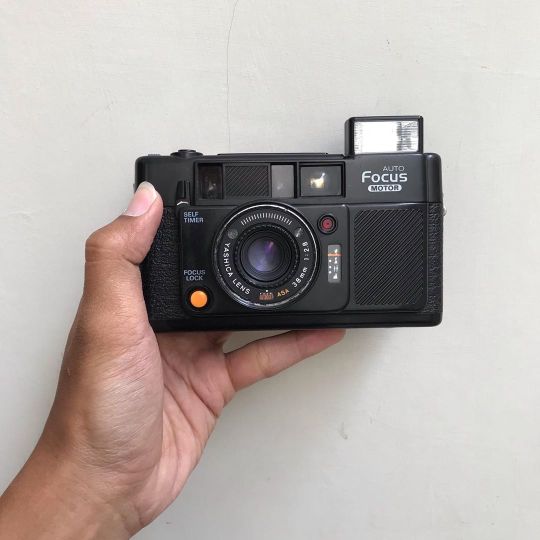
Kamera Film Yashica Auto Focus Motor Mekanik lancar, kokang jepret aman Flash ON Ada fitur Focus Lock dan Lock Shutter Counter film aman Video ada di slide akhir Mari silakan - Minat 085728394499 WA LINE - #ready_lawassoke #kamerayashica #kameraanalog #jualkameranalog #yashicaautofocus #kamerafilm #jualkamerafilm #film35mm #indo35mm #35mm #35mmfilm #jualkamerajakarta #jualkamerajogja #jualkameramalang #jualkameralawas #kameralawas #kamerajadul #jualkamerajadul #yashicaautofocusmotor #yashica https://www.instagram.com/p/B_WSvc-ns-F/?igshid=kmfth6969j9m
#ready_lawassoke#kamerayashica#kameraanalog#jualkameranalog#yashicaautofocus#kamerafilm#jualkamerafilm#film35mm#indo35mm#35mm#35mmfilm#jualkamerajakarta#jualkamerajogja#jualkameramalang#jualkameralawas#kameralawas#kamerajadul#jualkamerajadul#yashicaautofocusmotor#yashica
0 notes